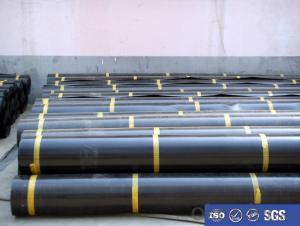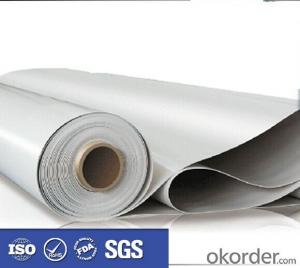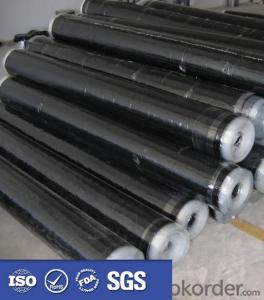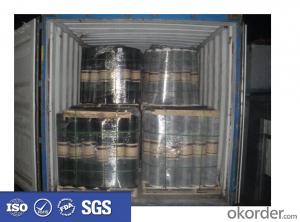EPDM Waterproof and Breathable Roofing Membrane
- Loading Port:
- Qingdao
- Payment Terms:
- TT OR LC
- Min Order Qty:
- 2000 m²
- Supply Capability:
- 8000000 m²/month
OKorder Service Pledge
OKorder Financial Service
You Might Also Like
Description Of EPDM Waterproof and Breathable Roofing Membrane:
Self adhesive waterproof rolling material:
thickness:1.2/1.5/2.0mm
length/roll:10/20m
width/roll:1.02m
Low temperature:-15 -20,-30
Main Features of EPDM Waterproof and Breathable Roofing Membrane:
1) High tear
2) High puncturing strength
3) Great temperature resistance.
4) High dimensional stability
Specifications of EPDM Waterproof and Breathable Roofing Membrane:
Material | EPDM Self-adhesive Waterproof Membrane |
Size | 1.2m (width)*20m (length) or customized, weldable type 2.05m or 4m width |
Thick | 1.2mm, 1.5mm, 2.0mm |
Type | Vulcanized & Weldable |
Pattern | Non-reinforced (homogeneous) |
Certificate | ISO9001/14001 |
Applications of EPDM Waterproof and Breathable Roofing Membrane:
1.It is widely used in civil and industry construction.
2.The waterproof,dampproof of the roofs,basements,toilets etc;
3.And the waterproofing of subway,underground,bridges,car parking,tunnels,reserviors,pool etc.
4.SBS modified bitumen waterproof membrane is specially suitable to the building waterproofing in cold area and to the buildings of changeable constructions
5.APP specially suitable to areas of high temperature and of strong sunshine.
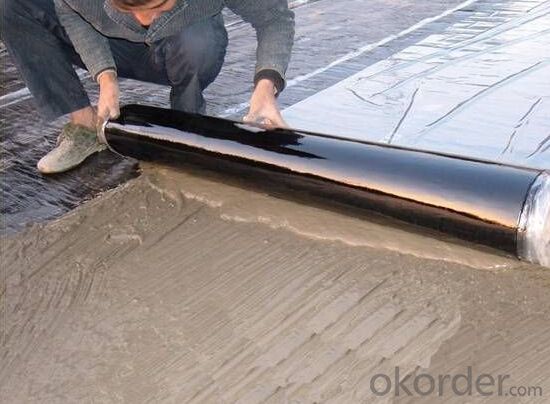


FAQ:
1. What are we supplying?
We are specialized in producing Colorful Asphalt Roof Shingle, SBS/APP modified bitumen waterproof membrane, Self adhesive bitumen waterproof membrane, PVC waterproofing membrane, EPDM rubber roofing membrane, Single Component Polyurethane Waterproof Coating, and Spray Polyurea Waterproof Coating.
2. How Many years experience do we have?
We have been exported to more than 20 countries in the past 15 years.
3. How long do we usually reply your request?
We always reply our customer within 24 hours.
- Q:Can waterproofing membranes be used on elevator pits?
- Yes, waterproofing membranes can be used on elevator pits. Elevator pits are prone to water infiltration due to their location below ground level, making them susceptible to water damage and leaks. Waterproofing membranes provide an effective solution to prevent water penetration and protect elevator pits from moisture-related issues. These membranes are designed to create a watertight barrier, usually made of materials such as rubber, polyurethane, or bitumen. They are applied to the walls and floor of the elevator pit, forming a seamless and durable protective layer. This membrane system helps to keep the pit dry, preventing water damage to the elevator components and ensuring the safe and reliable operation of the elevator.
- Q:Can waterproofing membranes be used on concrete tunnels?
- Concrete tunnels can benefit from the use of waterproofing membranes. These membranes are commonly employed to prevent water infiltration in various structures, including concrete tunnels. They are applied on the outside of the tunnel walls and can be made from different materials like bitumen, PVC, or EPDM. Their purpose is to stop water from seeping through the concrete. By creating a waterproof layer, these membranes safeguard the tunnel against water damage, such as corrosion, decay, and leaks. Moreover, they act as a protective shield against other sources of moisture, like groundwater or surface water. It is crucial to select a suitable waterproofing membrane that matches the specific conditions and requirements of the concrete tunnel, taking into consideration factors such as water pressure, chemical exposure, and temperature changes. To ensure the effectiveness and long-term durability of the waterproofing membrane in safeguarding the concrete tunnel from water ingress, proper installation and regular maintenance are essential.
- Q:Can a waterproofing membrane be used for highway or road projects?
- Highway or road projects can benefit from the utilization of a waterproofing membrane. These membranes are frequently employed in road construction to safeguard the underlying layers against water damage. Serving as a barrier, they effectively ward off water infiltration, thus averting the deterioration of the road structure. Application of these membranes is typically done on areas of high water exposure such as bridge decks, tunnels, and retaining walls. By preventing water from seeping into the road, the waterproofing membrane aids in prolonging its lifespan by mitigating moisture-related issues like cracks, potholes, and erosion. Furthermore, it enhances the road structure's durability and strength, bolstering its resistance against environmental elements. Ultimately, the integration of a waterproofing membrane in highway or road projects delivers long-term protection and ensures the endurance of the infrastructure.
- Q:Can a waterproofing membrane be used for below-grade applications?
- Below-grade applications can benefit from the utilization of a waterproofing membrane. Construction projects commonly employ this technique to safeguard basements, foundations, and retaining walls against water infiltration. The purpose of a waterproofing membrane is to create a barrier against water and moisture, thereby shielding the structure from potential harm. Generally, this membrane is applied to the exterior side of the below-grade structure, acting as a protective layer that hinders water from seeping into the building. The formulation of waterproofing membranes for below-grade applications is specifically tailored to withstand the considerable hydrostatic pressure exerted by surrounding soil and water. They are typically constructed from durable materials like modified bitumen, rubberized asphalt, or polyvinyl chloride (PVC), capable of enduring the challenging conditions commonly encountered below grade. Moreover, these membranes are designed to exhibit flexibility, enabling them to accommodate any movement or settlement that may occur within the structure over time. Ultimately, utilizing a waterproofing membrane for below-grade applications proves to be an effective and dependable method of preventing water intrusion and preserving the integrity of the structure.
- Q:Can a waterproofing membrane be used in rooftop gardens or green roofs?
- Yes, a waterproofing membrane can be used in rooftop gardens or green roofs. It is an essential component to prevent water leakage and protect the underlying structure from moisture damage. The membrane acts as a barrier, preventing water from penetrating the roof and causing potential structural issues. This ensures that the rooftop garden or green roof remains well-maintained and functional.
- Q:What is waterproofing membrane?
- waterproofing membrane, high polymer modified asphalt waterproofing membrane and synthetic polymer waterproofing membrane; according to the different carcass are divided into no carcass membrane, paper coil, glass fiber Tire Coil, Glass Fabric Coil and Polyethylene Tire Coil.
- Q:Does a waterproofing membrane affect the appearance or finish of a surface?
- The appearance or finish of a surface can be affected by a waterproofing membrane. When the membrane is applied, it forms a barrier that stops water or moisture from getting into the surface. The type of membrane used determines the impact it has on the surface. It can form a visible layer on top of the surface, changing how it looks. For instance, a clear liquid membrane can give it a shiny finish, while a sheet membrane can give it a textured or patterned surface. Some membranes may even alter the color or darken the surface slightly. Therefore, it's crucial to consider how a waterproofing membrane will affect the aesthetics of the surface before using it, particularly if maintaining the original appearance is important.
- Q:Can a waterproofing membrane be used in boat decks or marinas?
- Yes, a waterproofing membrane can be used in boat decks or marinas. Boat decks and marinas are constantly exposed to water, making them prone to damage and deterioration over time. A waterproofing membrane can provide an effective solution to protect these surfaces from water intrusion, preventing issues such as rotting, warping, and mold growth. The membrane acts as a barrier, preventing water from seeping into the underlying structure and causing damage. It also helps to maintain the structural integrity of the boat deck or marina, prolonging its lifespan. Additionally, a waterproofing membrane can enhance the safety of these surfaces by reducing the risk of slip and fall accidents, as it can provide a slip-resistant surface. Overall, using a waterproofing membrane in boat decks or marinas is a wise choice to ensure their durability, longevity, and safety.
- Q:What are the potential drawbacks or limitations of using a waterproofing membrane?
- Using a waterproofing membrane has the potential for a drawback if it is not installed properly. Incorrect installation can result in leaks and water damage. Proper application and sealing of the membrane require a certain level of expertise and attention to detail. Another limitation is that waterproofing membranes can be relatively expensive compared to other methods of waterproofing. The cost of purchasing and installing the membrane, as well as any necessary maintenance or repairs, can accumulate quickly. This may make it less feasible for individuals or organizations on a tight budget. Furthermore, waterproofing membranes are not a one-size-fits-all solution. Different types of membranes are suitable for different applications, and it is crucial to select the appropriate one based on the project's specific requirements. This can be challenging for individuals without experience in the field, as it requires knowledge and understanding of the available options. Another potential drawback is the limited lifespan of waterproofing membranes. Over time, they can deteriorate or become damaged, necessitating replacement or repairs. Fixing the issue may be costly and time-consuming, especially if the membrane needs to be removed and replaced. Finally, waterproofing membranes are primarily used for below-grade applications or on horizontal surfaces like roofs or decks. They may not be as effective for vertical surfaces such as walls or in areas with significant movement or stress, such as expansion joints. In such cases, alternative waterproofing methods may be more suitable. In conclusion, while waterproofing membranes provide excellent protection against water intrusion, they also have potential drawbacks and limitations, including improper installation, high cost, the need for expertise in selecting the right membrane, limited lifespan, and application limitations. It is important to consider these factors and explore alternative options before deciding on a waterproofing solution.
- Q:Can waterproofing membranes be used on utility manholes?
- Utility manholes can indeed benefit from the use of waterproofing membranes. These specialized membranes are specifically engineered to create a barrier against water infiltration, making them perfectly suited for areas where water is present, such as manholes. To prevent any potential damage to the structure or the utilities within, these membranes are typically applied to the walls and floors of the manhole, effectively preventing water from seeping through. This process not only maintains the integrity and functionality of the utilities, but also helps to avoid water-related issues like corrosion, leaks, and material degradation. Furthermore, waterproofing membranes offer additional protection against elements such as chemicals, gases, and soil contaminants that may be found in or around the manhole. Thus, the application of waterproofing membranes on utility manholes is a widely adopted practice to guarantee their long-term durability and functionality.
1. Manufacturer Overview |
|
|---|---|
| Location | |
| Year Established | |
| Annual Output Value | |
| Main Markets | |
| Company Certifications | |
2. Manufacturer Certificates |
|
|---|---|
| a) Certification Name | |
| Range | |
| Reference | |
| Validity Period | |
3. Manufacturer Capability |
|
|---|---|
| a)Trade Capacity | |
| Nearest Port | |
| Export Percentage | |
| No.of Employees in Trade Department | |
| Language Spoken: | |
| b)Factory Information | |
| Factory Size: | |
| No. of Production Lines | |
| Contract Manufacturing | |
| Product Price Range | |
Send your message to us
EPDM Waterproof and Breathable Roofing Membrane
- Loading Port:
- Qingdao
- Payment Terms:
- TT OR LC
- Min Order Qty:
- 2000 m²
- Supply Capability:
- 8000000 m²/month
OKorder Service Pledge
OKorder Financial Service
Similar products
New products
Hot products
Hot Searches
Related keywords
